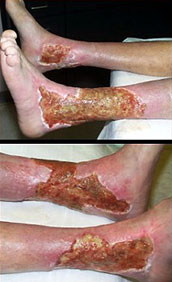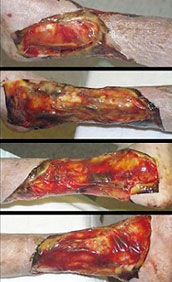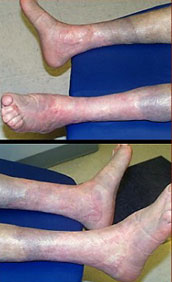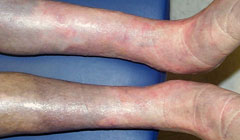
|
A 77-year-old woman had a 40-year
history of continuous leg ulceration and progressive
systemic illness. In spite of classic symptoms of
Sjogren's disease, the diagnosis was missed countless
times. When seen in consultation, the diagnosis
was made, anti-inflammatory and antimetabolic treatments
were started, and the patient's general health status
improved substantially. The leg ulcers are shown
just prior to excision. Proper excision means thorough
fasciectomy, removing all pathological tissues,
including the fibrotic, ulcerated, and inflamed
sural fascia. This means that muscles, tendons,
retinacular ligaments and other structures will
all be exposed when excision is complete. Skin grafts
will not cover these structures, and even if they
could in principle, here they would be at risk for
recurrent pathological lysis and ulceration.
|
 |


|
The legs and ankles are shown
one week after excision and Integra. Note the wrinkling
in the Integra, a common occurrence due to control
of inflammation and edema, thereby decreasing limb
volume and surface. All care was outpatient.
|
 |
|
The legs healed and have stayed
stable, shown here two years later. Note the bandaging
imprints, attesting to the patient's diligent efforts
to control edema and care for her skin. Consistent
rheumatology management has kept the patient healthy,
and lifestyle has been restored.
|
 |
|
A close-up view shows the quality
and texture of the healed wound and how comparable
it is in appearance to normal skin.
|
 |
Cases Courtesy of:
Marc E. Gottlieb, M.D., Jennifer Furman
Journal of Burns and Wounds, Vol 3, #2